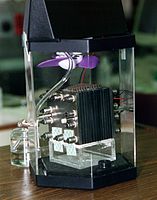
Photo from wikipedia
The paper presents the results of graphite-stainless steel composites for the bipolar plates in low-temperature fuel cells. The sinters were performed by powder metallurgy technology. The influence of technological parameters,… Click to show full abstract
The paper presents the results of graphite-stainless steel composites for the bipolar plates in low-temperature fuel cells. The sinters were performed by powder metallurgy technology. The influence of technological parameters, especially molding pressure were examined. Following the requirements formulated by the DOE concerning the parameters of the materials, it indicated by the value of the parameters. The density, flowability, particle size of graphite and stainless steel powders have been evaluated. Composites have been tested by microstructure and phase analysis, properties of strength, functional properties: wettability, porosity, roughness. The special attention was paid to the analysis of corrosion resistance obtained sinters and influence of technological parameters on the corrosion. Corrosion tests were carried out under conditions simulating the environment of the fuel cell under anode and cathode conditions. The effect of pH solution during working of the cell on corrosion resistance of composites have been evaluated. Contact resistance depends on roughness of sinters. Low ICR determined high contact area GDL-BP and high electrical conductivity on the contact surface. The ICR in anode conditions after corrosion tests are not change significantly; composite materials can be used for materials for BP in terms of H2.
Journal Title: Journal of Ecological Engineering
Year Published: 2018
Link to full text (if available)
Share on Social Media: Sign Up to like & get
recommendations!